| |
| |
Caption: War Publications - WWI Compilation 1923 - Article 28
This is a reduced-resolution page image for fast online browsing.

EXTRACTED TEXT FROM PAGE:
LA mm fill] Hotted to each operation can bUttlHMM- davs. without serious injury beyond a few Because 01 i"«» i » « i •• — •—* — r ~ — . . - —«* «••- " " p ***" * ,-i-illv be pushed with the greatest possible energy at these cril ^fpcriods. This can be done only by carefully planning so that 'he entire time of every man and horse may be used tt> the Inst ad •image. This means that every machine and tool be on hand, thoroly overhauled, and in as nearly perfect working condition as possible before the critical time comes. It means that seed be secured, cleaned, tested, and treated if necessary beforehand during less busy periods. So also has been somewhat definitely fixed, alt ho perhaps to a lesser extent, much of the work connected with live-Stock operations, such as feeding, breeding, and genera] management. Soni-fixed work can usually be shifted from one to three or four weeks. Beyond this it cannot ordinarily be moved without loss or disadvantage. Fall plowing and shock threshing are good illustrations of semi-fixed work. Movable work can usually be shifted over considerable periods. usually from one to two or three months, and frequently it can be shifted to almost any time during the year, depending on the time *hen it can best be fitted in. Hauling manure and other fertilizers and overhauling and repairing farm machinery, are good examples of movable work. This classification, however, can be at best only a general one. What would be at one time and place movable work mi gnt be at another semi-fixed, and vice versa. Plan to Fit Together the Three Classes of Work.—In the planning the farm work, the operator should aim to have the semi-fixed ^ork fit m between the fixed work just as largely as possible. The ^ovable work should be fitted in between the other two classes. If ls c a n be done, it will go a long way toward securing the greatest J^oiint of work from the labor at hand. The most successful farm£8 already carry out this scheme to a considerable extent, but even e y will need to study their operations and make every possible ^Provement during the period of war. Such improvements will be of s Pecial importance, however, on the large number of farms where the matter has received all too little attention up to date. "tody the Farm Work Calendar.—The accompanying work calen( ar Wing practically all of the operations that are likely to occur \\\ "-welt farm ana suuwuig mc O F pvA.^»«v ««^» »,..v. iarm, n : ^y should be done, may be helpful in planning the farm work. The lrT1 Portant aim in planning all farm work is to make sure that no 8enr u-fixed or movable work will need to be done when the critical cr °t> or live-stock operations must have the labor or suffer. Enough n JJ avoidable delays will still come in even with the best made plans, } ' Ut witV»/*„4. ~..-JL plans on Mi H P I R V S a m c e r t a i n t o bo miioli srvositov «vi«*no i
| |